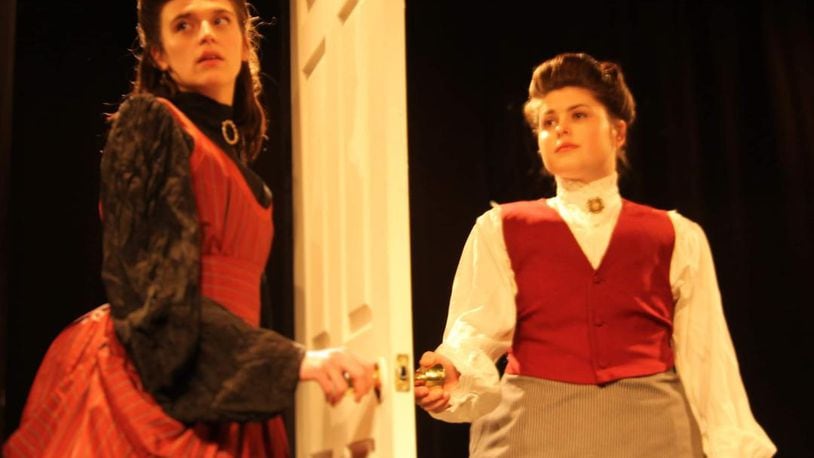The following week, Feb. 22-25 under the guest direction of Emily N. Wells, Hnath’s 2017 Tony Award-nominated play details Nora’s startling, dramatic and often humorous return to the family and home she boldly left behind. The New York Times noted “this unexpectedly rich sequel reminds us that houses tremble and sometimes fall when doors slam, and that there are living people within, who may be wounded or lost.”
“I love that the play presents Nora with the consequences of her actions and asks her to really value what she has found for herself versus what destruction she left behind in her wake,” said Wells, artistic director of the Human Race Theatre Company making her WSU directorial debut. “I think for men and women, making the choice to leave a relationship is one of the hardest decisions they make for many reasons including financial and emotional security. And during Ibsen’s time it was a very radical act to leave.”
Wells also admires Hnath’s ability to go deeper into Nora’s consciousness and empowerment in ways that surpasses Ibsen’s original idea.
“One of the things Lucas does really well is present not only Nora’s thought process in a deeper way than Ibsen was able to express perhaps but also presenting different aspects of generational feminism, which is a very interesting part of the play,” she said. “It’s like a boxing match. And in a way, it frees Nora completely by the end of the play because she’s able to put to rest any reservations she might have had in leaving and hopefully put to rest some things for those she left behind. The end provides closure with a sense of not necessarily hope but looking forward.”
Credit: WRIGHT STATE THEATRE
Credit: WRIGHT STATE THEATRE
Cordes says producing this experience arises as an example of “episodic theatre” akin to network television storylines. She hopes audiences are eager to witness Nora’s journey in its entirety.
“I was thrilled at the prospect of our students and audiences witnessing the whole Nora and Helmer family story, as it stands right now in literary history, in an exploration of episodic theatre,” said Cordes in a press release. “We used to watch network television in this way. One part of the story on a day/time one week with the following episode one week later. My hope is if an audience member is with us the first weekend for Episode One — what happened first — that they will live in suspense for a week to be with us for Episode Two — what happens next — to discover what occurs 15 years later from the end of the first play. New decisions and new perspectives unfold in all of the surprising ways that only the passage of time can allow.”
Both productions feature scenic design by student Anna Hunter, costume design by faculty instructor Zoe Still, lighting design by student Zach Wuest, and sound design by resident sound designer James Dunlap. Each will be held in the intimate black box Herbst Theatre of WSU’s Creative Arts Center as well.
“My style tends towards the minimal, so the world onstage will be stripped down to the essentials for the storytelling,” Wells added. “Anna Hunter has created an open forum for the debate of ideas. Zoe Still’s costumes fill the space with color, texture and silhouette without duplicating all period details.”
Wells also praises Wright State’s decision to produce both plays back-to-back and is excited for audiences to hear Hnath’s mastery of language and tone.
“Doing both plays is brilliant,” she said. “You see modern realism at its very beginning and then you see Lucas’ counterpoint to that version. Lucas keeps modern realism but it’s a very different approach, especially his use of language. Playwrights today feel freer in how they use language in text, which I think is awesome. I really appreciate it and it mimics so much how we speak today.”
HOW TO GO
What: “A Doll’s House”
Where: Herbst Theatre of Creative Arts Center at Wright State University, 3640 Col. Glenn Hwy., Dayton
When: Feb. 15-18: 8 p.m. Thursday and Friday, 2 p.m. and 8 p.m. Saturday, and 2 p.m. Sunday
Tickets: $5-$15
More info: 937-775-2500 or visit https://liberal-arts.wright.edu
What: “A Doll’s House, Part 2″
Where: Herbst Theatre of Creative Arts Center at Wright State University, 3640 Col. Glenn Hwy., Dayton
When: Feb. 22-25: 8 p.m. Thursday and Friday, 2 p.m. and 8 p.m. Saturday, and 2 p.m. Sunday
Tickets: $5-$15
More info: 937-775-2500 or visit https://liberal-arts.wright.edu
About the Author
